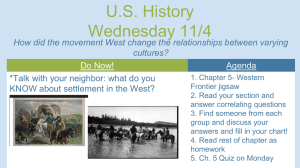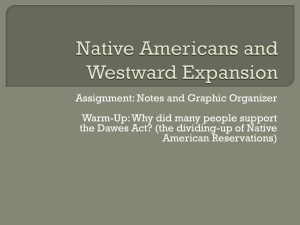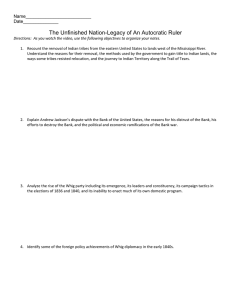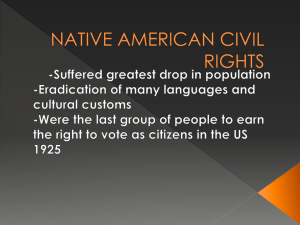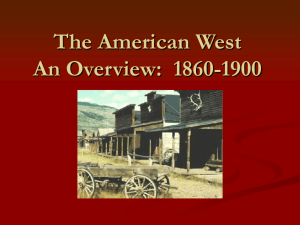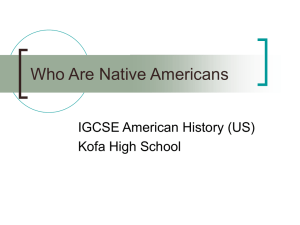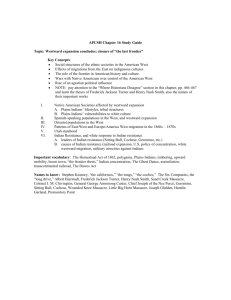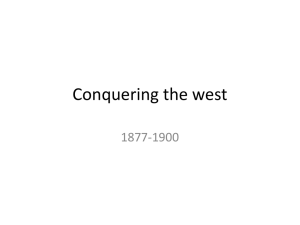Westward Movement
advertisement
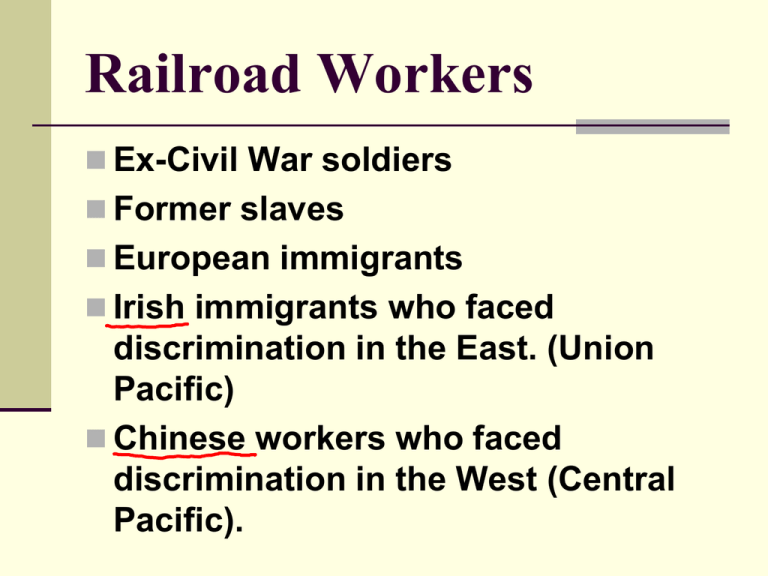
Railroad Workers Ex-Civil War soldiers Former slaves European immigrants Irish immigrants who faced discrimination in the East. (Union Pacific) Chinese workers who faced discrimination in the West (Central Pacific). Positives Paid jobs for many who could not find other work because of racism/prejudice. New start in the West. Challenges Low pay Dangerous work Native American attacks Use of explosives End of track towns known as “hell on wheels” Harsh conditions Cold and snow Extreme summer heat Populists The Grange – first farmers group 1872 – tried to reduce the cost of farming by organizing coops and businesses that could buy in bulk. Farmers’ Alliance: 1880 New, more radical farmers’ group began. Upset about low prices despite high demand, they wanted Government ownership of railroads and telegraph Free coinage of silver to inflate crop prices Lower taxes Populist Party 1892 – political party created by Farmers’ Alliance ant other with similar beliefs. Populism was a political philosophy that favored a common person’s interest over those of wealthy people or business interests. Monetary policy is aimed at controlling the supply and value of a nation’s currency. At that time, the U.S. had a gold standard – meaning that every paper dollar in circulation had to be backed by a dollar’s worth of gold in the U.S. Treasury. Populists supported a plan to use both silver and gold to back the currency. They believed this would fuel an increase in crop prices. Although the party faded from the scene following the election of 1896, it did inspire a new generation of reformers that would eventually rise to power in the U.S. American Indians Many tribes had already been pushed off of their land in the East and forced to relocate to the West (Cherokees and the Trail of Tears) by the Indian Removal Act of 1830. The western migration during the last half of the 1800s eventually caused the end of American Indian culture as it had been. The railroad was a threat to the very existence of the American Indian culture. Cut through buffalo hunting grounds. Brought ranchers, farmers, and soldiers In response, tribes fought the railroad. This battle for survival represented the last round of the Indian Wars. Cultural Differences Settlers believed in individual land ownership while Indians did not. Nomadic Indian tribes who relied on the buffalo for food, clothing and shelter, clashed with farming tribes trying to protect their land. American Indian tribes refused to give up their land without a fight as more and more settlers flooded into the West. Warriors began to attack settlers. U.S. Response 1864 Sand Creek Massacre – 150 peaceful Cheyenne men, women and children, are murdered by U.S. Cavalry. The federal government tried to confine most western tribes to reservations in an attempt to end the conflict. But as settlers began to want the reservation land for themselves, the government violated the treaties and take the land from the tribes. 1876 Sioux and Cheyenne, who refused to stay on reservations, defeated General Custer at the Battle of the Little Big Horn. 1877 Chief Joseph of the Nez Perce surrenders. “My heart is sick and sad. From where the sun now stands, I will fight no more forever.” 1886 Apache Chief Geronimo and his followers are captured and held as prisoners of war. American Indian resistance ends. 1890 Wounded Knee Massacre – 300 men, women and children Sioux were gunned down by U.S. Cavalry. The massacre shocked the nation and broke Indian resistance on the Plains. Within a few years, the army had subdued the major tribes of the Great Plains. Reformers had grown concerned that the Indians on reservations were not improving the themselves and not becoming self-sufficient. 1887 The Dawes Act: The purpose was to dissolve the reservation by forcing individual Indians to live on small family farms. Every Indian would receive 160 acres of land with extra land to be sold. A second purpose of the act was to destroy Indian communalism, thereby destroying their culture. The U.S. government want to assimilate the Indians or “Americanize” them. It wanted the Indians to abandon their culture and live like white Americans. Assimilation: absorb into the dominant culture. Americanization: make into white “Americans” The End of the Western Frontier 1890 The U.S. Census Bureau issued a report declaring the “frontier closed.” There had been so many settlements that they had broken up the open land, meaning that there no longer was a frontier area to be settled. What next?
